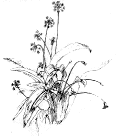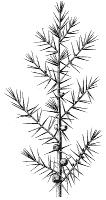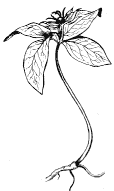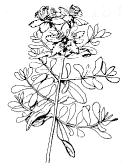|
|
|

- Herbalism (Mental 2, Intelligence/Knowledge -2) — Those with herbalist
knowledge can identify plants and fungus and prepare simple nonmagical
potions, poultices, powders, balms, salves, ointments, infusions
and plasters for medical and pseudo-medical purposes. They can
also prepare natural plant poisons and purgatives. The DM must
decide the exact strength of such poisons based on the poison
rules in the DMG. A character with both Herbalism and Healing skills gains bonuses when using his Healing talent (see the Healing
skill). Complex brews (those which require the use of several
different ingredients in combination) cannot be made by a character
with the Herbalism skill. These brews are the purview of the character
with the advanced skill, Herbal Magic.
- A knowledge of herbs, particularly those with poisonous qualities
is of value to Assassins, Bounty Hunters and other nefarious types.
Scouts often learn the types and properties of plants on their
wilderness journeys.
- Barbarians: A barbarian may only identify and work with vegetation native
to his homeland terrain. A barbarian attempting to utilize this
skill outside his homeland terrain does so at a -40% penalty.
If he has both the Healing and Herbalism skills, he may prepare
and treat poisons in accordance with the restrictions outlined
in the Healing skill description. With the DM’s permission, it
can be assumed that a barbarian carries a reasonable number of
healing and poisonous herbs from his homeland.
- Cultivation of herbs: Many herbs can be grown easily in a garden, however, this activity
requires some skill in Agriculture. A character with both the
Agriculture and Herbalism skills can attempt to grow and harvest herbs properly.
Both Agriculture and Herbalism skill checks are required for success.
Agriculture Tables 5.3.00-5.3.03 can be used with slight modification to determine the success
of the crop. When attempting to grow any of the special herbs
listed below, the skill modifier is applied to both the Agriculture
and Herbalism skill scores of the character.
- Special herbs: Some well-known herbs that can be utilized by characters without
access to healing magic are listed below. The herbs are listed
using the following format:
- Terrain: Some herbs grow in a limited terrain and there is no
chance to find them outside that terrain type.
- Search Time/Skill Modifier: Based on rarity, it may take longer
to search for some herbs than others. Search times are listed
in hours. The skill modifier, listed as a bonus or penalty to
the skill score, reflects the rarity and difficulty of identifying
an herb.
- Doses: This is the number of doses that can typically be collected
through a single search.
- Value: This is the value of a single dose of a particular herb
in the market of a major city or trade center.
- All herbs can be eaten raw, either fresh or dried. When searching
for special herbs, a single area can only be searched one time
effectively; repeated searches of the same area incur a cumulative
-10% penalty to the character’s Herbalism skill score.
- An extensive list of herbs is included in the 1st edition DMG, “Appendix J: Herbs, Spices and Medicinal Vegetables,” pg. 220-221.
Acantha leaf
Terrain: Undisturbed forest groves
Search Time/Skill Modifier: 4/-20%
Doses: 1d10
Value: 200 gp per dose
- Effects: Adventures prize this velvet-leafed, dark green herb for its ability to heal cuts and bruises. It grows only in undisturbed forest groves and is rarely found in large patches. A single dose of the leaf heals 1d8 hit points of damage over a period of a turn. A single plant provides 1d10 doses.
Amaranth
Terrain: Coastal grasslands
Search Time/Skill Modifier: 12/0
Doses: 1d8
Value: 1 gp per flower
- Effects: This dark reddish purple flower is poisonous to wereseals (save vs. poison or die) and can be used to repel the beasts. A wereseal who fails a save vs. poison will not attack a character wearing this herb unless it is attacked first.
Belladonna
Terrain: Forests
Search Time/Skill Modifier: 12/0
Doses: 1d12
Value: 4 sp a sprig
- Effects: This herb is poisonous to werebears (save vs. poison or die) and can be used to repel the beasts. A werebear who fails a save vs. poison will not attack a character wearing this herb unless it is attacked first.
- In addition, belladonna has a 25% chance to cure lycanthropy if consumed within an hour of being wounded by any type of lycanthrope. The cure incapacitates the character for 1d4 days. Note, only a sprig of belladonna needs to be eaten and it must be reasonably fresh (picked within the last week). If too much is eaten, the character may still be cured, but is incapacitated for 2d4 days.
Cactacae cactus
Terrain: Smoking Glass Desert
Search Time/Skill Modifier: 6/+5%
Doses: 1d10
Value: 50 gp per dose
- Effects: The spines of this small round cactus when carefully harvested and chewed can heal minor scarring.
Calamia fruit
Terrain Warm swamps and marshes
Search Time/Skill Modifier 12/-20%
Doses 1d4
Value: 100 gp per fruit
- Effects: This large light red, almost pink fruit has the ability when it is eaten to cause broken bones to heal. If the fruit is eaten fresh the healing time is 1d3 days. Dried fruit, however, is more effective and causes bones to knit in 12 hours.
- The fruit is most easily harvested in the summer. Harvesting during spring or autumn incurs an additional -40% penalty. Winter harvest is very unlikely, even in the warmest climates; the penalty is an additional -80%.
Camphor
Terrain: Forests
Search Time/Skill Modifier: 12/0
Doses: 1d10
Value: 8 sp per 4 oz.
- Effects: This herb is poisonous to wereboars (save vs. poison or die) and can be used to repel the beasts. A wereboar who fails a save vs. poison will not attack a character wearing this herb unless it is attacked first.
Dugmuthur berries
Terrain: Cold mountains and hills
Search Time/Skill Modifier: 12/-25%
Doses: 1d6
Value: 300 gp per berry
- Effects: Much like acantha leaf, the dark blue berries of the Dugmuthur bush have remarkable healing properties. However, it is more potent than the more common acantha. When eaten, Dugmuthur berries heal 1d10 hit points in a single round.
 Ephlox moss Ephlox moss
Terrain: Stream banks
Search Time/Skill Modifier: 18/-20%
Doses 1d4
Value: 300 gp per dose
- Effects This rare fungus, that grows best on the bark of green sack trees which are exposed to plentiful sunlight, has a property which stops bleeding from a critical limb wounds. The herb has no effect on bleeding wounds in the abdomen, chest or head. Ephlox moss has a horrible taste, but must be eaten to take effect.
Fennel
Terrain: Grasslands
Search Time/Skill Modifier: 8/0
Doses: 1d10
Value: 1 sp per oz.
- Effects: This herb is poisonous to werejackals (save vs. poison or die) and can be used to repel the beasts. A werejackal who fails a save vs. poison will not attack a character wearing this herb unless it is attacked first.
 Garlic Garlic
Terrain: Damp grounds
in meadows and sparse forests
Search Time/
Skill Modifier: 4/0
Dose: 2d20
Value: 3 cp per clove
- Effects: This herb can be applied to wounds to encourage healing. It can also be used to heal one hit point of damage caused by a bite or sting of an insect. More importantly, the herb has supernatural qualities which can be used to repel vampires.
- Garlic in powdered form, bud or intact plant has an odor that is offensive to vampires. It does not harm or permanently repel them, but causes them to hesitate for 1d4 rounds before attacking. Garlic butter smeared on creatures or doorways or liquid garlic — cooked into oil in a high concentration — sprayed or splashed on beings or areas will cause similar hesitation. Such applications of garlic will be effective for two days. On the third day, the waning power of the garlic will cause only a one round hesitation and thereafter the garlic will have evaporated and dissipated to such an extent that it will be completely ineffective. This is a chemical effect and cannot be extended or made permanent by known magic, short of a limited wish.
- Garlic seems to be effective only against vampires. The sage Aldiver, who has made a study of such matters, believes that is effectiveness is due to two factors: A strong chemical revulsion and an instinctively perceived peril to the gaseous form of the vampire, with which the garlic reacts. This reaction slows the change over between solid and gaseous form to a two-round process, during which time the vampire is vulnerable to all attacks, that is, normal weapons as well as magical ones.
- In order to be affected the vampire must be within 40 feet of the garlic or been exposed to it in the last 14 rounds. A vampire knows garlic is somehow dangerous to it, even if it has never encountered garlic before.
Ginseng
Terrain: Cold hills and plains
Search Time/Skill Modifier: 12/-5%
Doses: 1d4
Value: 3 sp per 4 oz.
- Effects: The root of this herb is poisonous to weretigers (save vs. poison or die) and can be used to repel the beasts. A weretiger who fails a save vs. poison will not attack a character wearing this herb unless it is attacked first.
Heliotrope leaf
Terrain: River banks
Search Time/Skill Modifier: 24/-30%
Doses: 2d20
Value: 50 gp per leaf
- Effects: This small tree grows in colder, wet areas, such as along river banks. Although rare, the leaf of the Heliotrope tree is famed for its amazing ability to heal serious and critical head wounds. When eaten the leaf of this tree will negate any continuing effects of a critical wound to the head (such as a temporary ability score penalty or bleeding). However, it has no effect on other wounds and heals only one hit point of damage.
 Juniper berry Juniper berry
Terrain: Heath and sparse forests
Search Time/Skill Modifier 2/0
Doses: 1d10
Value: 25 gp/dose
- Effects: Juniper is a bush with thick branches bearing short, scale-like needles similar to pine needles. The bark is rough and has a shredded appearance. The entire bush is very fragrant. Clusters of berries are green in the first year of their growth and turn dark purple when they ripen the following year. Each berry has a strong distinctive taste.
- Juniper berries help counteract all forms of poison, but most importantly juniper is a powerful stimulant. When a mortally wounded character (one with 0 to -9 hit points) is forced to eat two juniper berries, he will regain 1d4 hit points and return to consciousness. A character revived in this manner cannot fight or engage in other strenuous activity until he has a positive hit point total. However, if he succeeds in a saving throw vs. death magic, he may be able to cast spells, eat additional herbs, use psionic abilities or perform other activities which require little or no movement.
- Juniper berries eaten within two rounds of poisoning allow the character to save with a +1 bonus.
- In addition, juniper berries are poisonous to werefoxes (save vs. poison or die) and can be used to repel the beasts. A werefox who fails a save vs. poison will not attack a character wearing this herb unless it is attacked first.
- Note, juniper berries have a strange effect on members of the sylvan races (elves, half-elves, pixies, etc.). If a member of one of these races eats even one juniper berry, that character must make a saving throw vs. poison or be affected by an uncontrollable attraction to the first member of the opposite sex that the character sees. The object of the character's attraction may be of any race as long as the character's normal racial preference for that race is not “hostile.” This effect last for 2d4 rounds and does not negate the beneficial effects of the herb.
Knipweed
Terrain Shady patches of forest
Search Time/Skill Modifier 4/-10%
Doses 1d10
Value: 10 gp per dose
- Effects: Knipweed grows in secluded shady patches in forest throughout the northern temperate regions of Fälgorna. Priests and healers prize this uncommon healing herb for use in aiding the sick and wounded. When used as part of the material components for a healing spell it adds +2 to the hit points healed. Powdered knipweed mixed with beeswax and water makes a powerful salve which adds +2 to the chance of success and +1 to hit points healed when using the Healing nonweapon skill.
- Knipweed looks like mint with a broader leaf and tiny white flowers. It is most common in the Bramble Forest.
Mandrake
Terrain: Swamps
Search Time/Skill Modifier: 12/-5%
Doses: 1d2
Value: 10 gp per root
- Effects: This herb is poisonous to werecrocidiles (save vs. poison or die) and can be used to repel the beasts. A werecrocidile who fails a save vs. poison will not attack a character wearing this herb unless it is attacked first.
Mangrove
Terrain: Tropical coastal forests
Search Time/Skill Modifier: 4/0
Doses: 1d20
Value: 1 sp per oz.
- Effects: The leaf buds of this tropical tree are poisonous to weresharks (save vs. poison or die) and can be used to repel the beasts. A wereshark who fails a save vs. poison will not attack a character wearing this herb unless it is attacked first.
 One berry One berry
Terrain: Light woods
and copses
Search Time/
Skill Modifier: 4/-5%
Doses: 1d2
Value: 20 gp per dose
- Effects: This moderately rare plant has a small creeping root just below the surface ground from which spring clusters of leaves, some of which have one starlike white flower or one blackish-purple berry. A leaf has four leaflets set at right angles to each other in a cross-pattern.
- This herb is useful as an antidote for poisons and as an antiseptic. If poison is suspected, the victim should eat at least three berries from the plant or ingest several leaves. Ingesting the herb will add +2 to saving throws vs. poison, but is more effective for dwarves, halflings, uldra and gnomes, who receive a +3 bonus to saving throws.
- If the leaves and berries of the plant is crushed and applied to a wound it will restore one hit point.
Poppy seed
Terrain: Grasslands, hills
Search Time/Skill Modifier: 12/0
Doses 1d20
Value: 8 gp per ounce
- Effects: Poppy seeds are poisonous to werebadgers (save vs. poison or die) and can be used to repel the beasts. A werebadger who fails a save vs. poison will not attack a character wearing this herb unless it is attacked first.
Pothnir grass
Terrain: Sunlit marshes and wetlands
Search Time/Skill Modifier: 24/-70%
Doses: 1d4
Value: 2,500 gp
- Effects: This bitter marsh grass is extremely rare but indispensable to a character without access to magical healing. It takes one round to gag the stuff down, but it has the effect of stopping bleeding from any type of wound and negating temporary ability score penalties caused by critical damage. In addition it heals 4d8 hit points.
Skullcap
Terrain: Forests
Search Time/Skill Modifier: 12/-10%
Doses: 1d6
Value: 1 gp per dose
- Effects: This herb is poisonous to werebats (save vs. poison or die) and can be used to repel the beasts. A werebat who fails a save vs. poison will not attack a character wearing this herb unless it is attacked first.
 Sovyn bush Sovyn bush
Terrain: Plains
Search Time/Skill Modifier: 1 week/-90%
Doses: 1d2
Value: 15,000 gp per dose
- Effects: The sun-dried, yellow flowers of this extremely rare bush which only blooms in early autumn have the miraculous property when consumed of stimulating the regrowth of an entire limb (or other body part) in a manner similar to a regeneration spell. However, unlike the regeneration spell, the process takes place over a week's time.
- The harvesting time for these flowers is crucial, for they must be naturally dried by the sun to be effective. Flowers which are not ready when harvested are instead a virulent poison. If a character eats a flower harvested before it is ready, they must save vs. poison at -4 or die in 1d4 rounds (on a skill check of 96-00, a poison flower is harvested).
Wakemoss
Terrain: Swamp
Search Time/Skill Modifier: 8/-20%
Doses: 1d6
Value: 10 gp
- Effects: When heated and eaten, this bittersweet substance keeps the individual awake and alert, effectively negating the need for a full night’s sleep.
Wolifrew lichen
Terrain: Cold wet caves
Search Time/Skill Modifier: 24/-70%
Doses: 1d3
Value: 5,000 gp per dose
- Effects: An exceedingly rare fungus known for its ability to cure nervous system disorders, wolifrew lichen grows only in cold, dark areas. Its yellow-brown color makes it difficult to distinguish from other common lichens, but it can be easily identified by its salty, nut-like taste.
- When eaten within 24 hours of suffering critical damage which has resulted in the permanent loss an ability score point, the lichen has the effect of restoring brain tissue and thus negating the loss of ability.
Wolfsbane
Terrain: Forests
Search Time/Skill Modifier: 8/0
Doses: 1d12
Value: 3 sp per 6 oz.
- Effects: This herb is poisonous to werewolves (save vs. poison or die) and can be used to repel the beasts. A werewolf who fails a save vs. poison will not attack a character wearing this herb unless it is attacked first.
Woth flower
Terrain: Mountains and high hills
Search Time/Skill Modifier: 12/-30%
Doses: 1d6
Value: 1,200 gp per blossom
- Effects This star-shaped cream-colored flower found only in small patches on rocky ledges has miraculous healing properties. A single blossom when consumed heals 20 hp in a single round.
Yavethalion root
Terrain: Coastal
Search Time/Skill Modifier: 48/-75%
Doses: 1d2
Value: 3,000 gp per dose
- Effects: This uncommon tree, which grows on beaches and saltwater coastlines, on rare occasion develops tuberous growths on its roots which have astounding healing properties. The small greenish tubers are extremely bitter but when eaten heal 10-60 hp of damage over the course of two rounds.
|